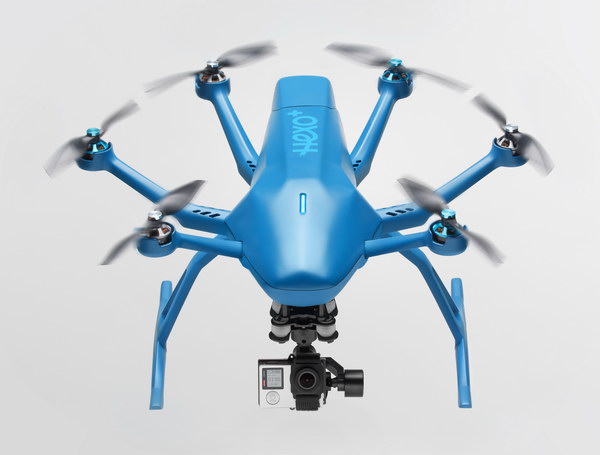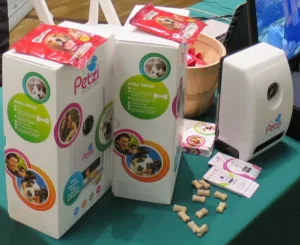BYOD can mean either Bring Your Own Device or Bring Your Own Display. The first meaning is often applied in the corporate world where it means an employee supplies their own smartphone, tablet or laptop computer for use in an enterprise to do corporate work. The company would then install software on the device to keep personal and corporate data separate from each other and keep the corporate data secure.

The second meaning of BYOD is what I want to talk about today: Bring Your Own Display. In the past, sophisticated systems, such as toys and home security systems, would have used a display with a user interface for control. Another example would be a home baby monitor with the camera looking at the crib and the display in the parent’s bedroom. In the home security example, the display might have been in the kitchen and shown video from security cameras, including one that was aimed at a front door visitor, as well as status indicators for the system as a whole.
Smartphones are nearly ubiquitous now, especially among those that are likely to have a sophisticated toy, home security system or baby monitor. In addition, smartphone owners don’t want just to see who is at the front door from the kitchen or be sure the baby is sleeping from their bedroom, they want to be able to check up on things from anywhere in the world. My neighbor, for example, checks to make sure the furnace in his mother’s house in the Catskill Mountains is working and keeping the pipes from freezing while his mother is comfortably spending the winter in Florida.
Consumer system manufacturers have come on-board with this trend with considerable enthusiasm. Not only does it broaden the market for their products but it makes them less expensive to manufacture and install. Instead of a video cable from the camera to a dedicated monitor, perhaps passing through a video matrix switcher, the camera is Wi-Fi equipped and the control box has neither display nor human interface. Instead, the manufacturer supplies an Android or iOS app. This app typically routs the data over the Internet to the user, whether he is at home, at work or traveling half way around the world. The smartphone or tablet touch screen then serves both the display screen and the user interface.
If you go to any technology-enabled event, especially one featuring startups, you will see BYOD in full force. For example, I recently attended a Pepcom event in New York that focused on technology you could give for Christmas this year. They were showing products, not blue-sky ideas. Some of it was kind of goofy, like Petzi Treat Cam. (www.petzi.com) This hangs on your wall and includes a camera, microphone, speaker and a dispenser for small treats. And an internet connection, of course. You can log into your Petzi Treat Cam from anywhere in the world and talk to your pet. You can also see and snap pictures of him. Finally, if it is a good dog or cat, you can dispense one of the small treats you loaded before you left home.
Right now, the video is only one-way. If the video were two way like the audio, I could see a manager using it as a video conferencing system and if you were good little employee, he could dispense an M&M or a Tootsie Roll. The treat cam is available now for $170. The iOS or Android app can be downloaded for free so you can share your pet with all your friends. Even if you don’t have a friend with a Petzi Treat Cam, you can join what the company calls the Social Petwork and look at dog and cat photos uploaded by people who do have a Treat Cam.
Petzi Treat Cam at the Pepcom Holiday Spectacular
Perhaps this wasn’t even the silliest connected item at Pepcom. I think I’d reserve that for the Bluetooth equipped Digitsole. If your feet get cold, you can open the Digitsole app and get a reading on just how cold your feet are. You can also activate the built-in heater to warm them up, if necessary, for up to 4 hours with power from the built-in rechargeable battery. Maybe it’s not so silly if you work outside and get cold feet. The Digitsole is not available yet and the firm was showing engineering samples at Pepcom.
Toys are a product category where BYOD has virtually taken over. I have gone to the Toy Fair in February for the last several years and have noticed that fewer and fewer toys have built in displays or GUIs. Five years ago, they did, but now the displays are almost all gone and tech toys are controlled by a smartphone or tablet. Remote control for your drone? Sure – Android or iOS?
For example, the Hexo+ Drone was at Pepcom, but, unfortunately, not flying. It was designed to fly the GoPro 4K and 360cam, allowing users to get “stunning aerial footage.” Remote control with a joystick? Don’t be ridiculous, just use their iOS 9 or Android 4.4 app. And let your app fly it hands-free on a preprogrammed course. One of the video examples on the Hexo+ website is a pair of mountain bikers being followed by their drone taking aerial footage of them. Hexo+ began in June 2014 as a Kickstarter campaign and raised its $50,000 funding target in just 37 minutes. It is available for pre-order now at the Hexo+ website (https://hexoplus.com/) for $1,349, GoPro camera not included.
 The Hexo+ drone started as a Kickstarter campaign in 2014
The Hexo+ drone started as a Kickstarter campaign in 2014
One of the issues I asked the various vendors at Pepcom about was compatibility. This is a special problem in the home control and automation space, where you can monitor and control your thermostat, front door lock, security system, indoor and outdoor lighting systems, basement flood detector, carbon monoxide detector and a myriad of other things. How many apps do you need? One (hopefully) if all the controls come from one source. Otherwise, hopefully, one per company. Unless, of course, the company upgrades their hardware and software and doesn’t support the home thermostat you bought last year with the app that controls the home lighting system you bought this year.
There are a couple of “standards” that aren’t really standards – they are proprietary systems. For example, there is Apple HomeKit for iOS 9. (http://www.apple.com/ios/homekit/) Don’t look for an Android app for this! At Pepcom, Ecobee was showing its new Ecobee3 home thermostat which is claimed to be the first thermostat that is compatible with Apple HomeKit. Besides a HomeKit app, they offered an Android app as well. Of course, if he has an iPhone and she has a Samsung phone, compatibility may be a problem.
While Philips wasn’t at Pepcom, the Philips Hue smart lights can take cues from Siri via the Apple HomeKit as well. Comcast has it’s own system, Xfinity, under the catch phrase, “Works With Xfinity Home One platform. One log-in. One app.” The Nest thermostat, now owned by Google, works under the Xfinity system. Nest (i.e. Google) also has a similar catch phrase and logo to go with it: “Works with Nest.” The Nest website lists about 45 product lines that can be controlled by the Nest app and they say more are coming all the time.

A lot of these BYOD products are developed by small startups with limited financing such as Hexo+. Will they now have to develop multiple apps? Not just Android and iOS, but a Xfinity, Google Nest and Apple HomeKit app as well? Maybe it’s time for some real standards. –Matthew Brennesholtz

